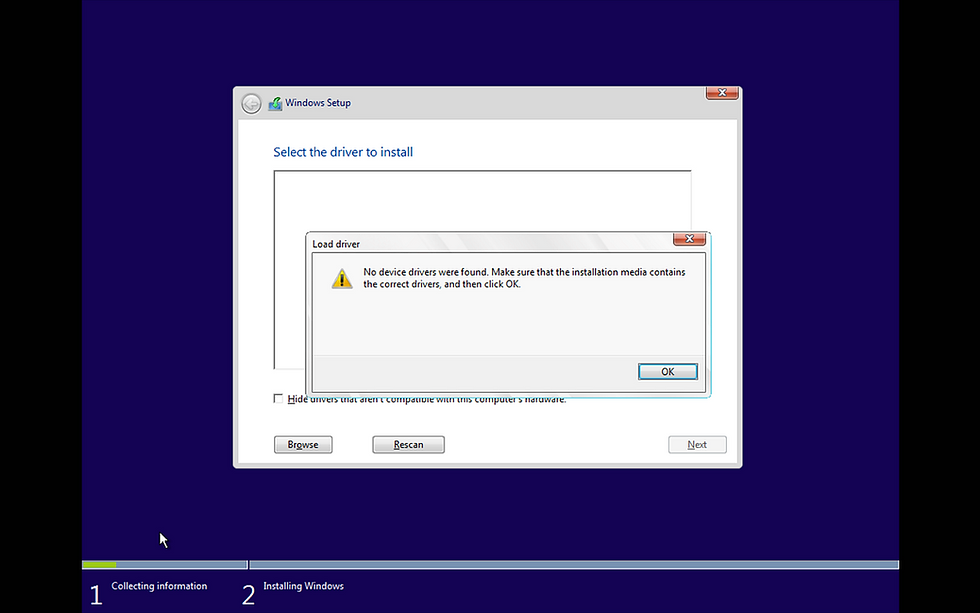"No Drive Found" During OS Reinstallation on Intel 11th, 12th & 13th Gen Systems – Cause, Impact & Resolution Using Intel IRST
- Stark

- Aug 8
- 3 min read
Reinstalling Windows on systems with modern Intel processors (11th, 12th, and 13th Gen) can sometimes result in a frustrating error:
"No drives found. Click Load Driver to provide a mass storage driver for installation."
This blog offers a deep dive into the root cause, impact, and step-by-step resolution using Intel Rapid Storage Technology (IRST) drivers.
🔍 Understanding the Problem
During OS reinstallation (OSRI) on newer Intel platforms, especially on laptops and desktops released post-2020, the Windows setup fails to detect the storage drive (NVMe/SSD), even though it is present in BIOS and works in the factory-shipped OS.
Typical error message:
"We couldn’t find any drives. To get a storage driver, click Load Driver."
This is especially common on Dell, HP, Lenovo, and Acer systems with Intel 11th/12th/13th Gen CPUs.

⚠️ Cause of the Issue
The root cause lies in the default SATA/NVMe controller mode set in BIOS:
BIOS Option | Description |
RAID / Intel RST | Enables Intel Rapid Storage Technology (default on OEMs) |
AHCI | Standard SATA/NVMe mode supported natively by Windows |
Modern systems with 11th Gen or newer CPUs come preconfigured in RAID/IRST mode, which Windows setup cannot natively detect without proper drivers.
❗ The NVMe SSD is hidden unless the appropriate IRST (Intel Rapid Storage Technology) driver is loaded.
🎯 Impact
OS reinstallation fails due to lack of drive detection
Confusion among users and technicians
Leads to incorrect assumptions of SSD failure
Time-consuming support interactions
🛠️ Resolution – Step-by-Step Fix Using IRST Driver
✅ Option 1: Load IRST Driver During Windows Installation
Recommended if you want to keep RAID/Intel Optane features enabled.
🔧 Step 1: Download the Intel RST Driver
From another working system, visit the official link:👉 Intel RST VMD Driver Download
Choose the F6 Floppy driver version for your generation (ZIP file).
Extract the zip file to a USB drive.
You should now see folders like VMD and .inf/.sys files inside.
🔧 Step 2: Boot to Windows Installation Media
Insert Windows USB installation media and boot to it.
Select language → Click Install Now
On "Where do you want to install Windows?" screen, you’ll see no drives.
🔧 Step 3: Load the IRST Driver
Click on Load Driver
Insert your USB with IRST drivers
Browse to the folder where the iaStorVD.inf or iaStorAC.inf is located
Select it → Click Next
✅ Your NVMe/SSD drive will now be visible!
🔧 Step 4: Proceed with Installation
Select the SSD
Delete all existing partitions (if needed)
Proceed with clean installation
✅ Option 2: Change BIOS Mode from RAID to AHCI (If RAID is Not Needed)
Simpler method if RAID or Intel Optane is not being used
⚠️ Warning:
Switching from RAID to AHCI after Windows is already installed can cause boot failure. For clean install, it's safe.
🔧 Steps:
Enter BIOS/UEFI Setup (F2, DEL, or ESC during boot)
Go to Storage Configuration / SATA Mode
Change mode from RAID/Intel RST to AHCI
Save and Exit BIOS
Boot into Windows Setup
Now Windows Setup will natively detect the SSD. No need to load IRST drivers.
💡 How to Identify Which IRST Driver to Use?
Intel Generation | VMD Supported? | Driver Needed |
10th Gen | No | Standard RST |
11th Gen | Yes | VMD RST (iaStorVD) |
12th Gen | Yes | VMD RST (iaStorVD) |
13th Gen | Yes | VMD RST (iaStorVD) |
If your BIOS has a VMD Controller option, IRST with VMD support is required.
✅ Best Practices
Always check BIOS storage mode before OSRI
Keep latest IRST driver USB ready
For enterprise or support teams, integrate IRST into custom Windows ISO using tools like NTLite or DISM
Consider using Dell/HP OEM recovery tools that preload IRST drivers
📌 Summary
Category | Details |
Issue | No drive found during OS installation on Intel 11th–13th Gen CPUs |
Root Cause | Storage controller set to RAID (Intel RST) – needs external driver |
Fix Option 1 | Load Intel IRST driver during install (recommended for RAID setups) |
Fix Option 2 | Switch BIOS storage mode to AHCI (if RAID/Optane not needed) |
Driver | Intel RST F6 Driver (iaStorVD or iaStorAC) from Intel.com |
📥 Resources
Intel IRST Download Center
Microsoft DISM Driver Injection Guide
NTLite Custom ISO Creation
If you’re a support engineer or a tech-savvy user, understanding this issue will save you hours of confusion. For OEMs, integrating IRST drivers in your recovery image is a must to prevent installation failures on modern hardware.



Comments